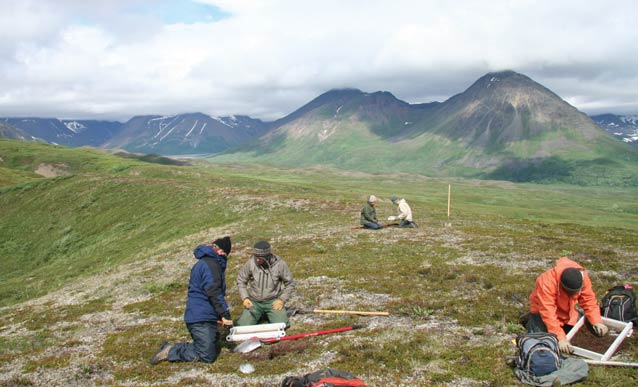Understanding the ancient people of Beringia is essential to testing hypotheses about how humans colonized the Americas.

More than 40 years ago, an archeological discovery at the site known as Teklanika West in Denali National Park and Preserve provided direct material evidence that prehistoric people lived in the central Alaska Range around 7,000 years ago. They used stone tools that were remarkably similar to tools found in Siberia dated to the Ice Age. A site at Dry Creek just northeast of Denali was excavated in the 1970s. This site was determined to be much older than Teklanika West, dating to the end of the last Ice Age (13,000 to 12,000 years before present).
Because the Dry Creek site is merely a stone’s throw from Denali, archeologists have long suspected that ice-age hunters also frequented the area now within park boundaries. However, the rugged landscapes of Denali are difficult to survey, and no archeological discoveries from the Ice Age had been found within the park—until recently.
Parkwide Survey Finds Upland Hunting Site
With more than 6 million acres of unspoiled wilderness, Denali’s landscapes encompass an untold wealth of archeological sites that have remained intact, largely because they are protected from such disturbances as development. In 2006, the park initiated a four-year survey to learn more about known and potential archeological sites in Denali. Brian Wygal, then an archeology graduate student at the University of Nevado Reno, was hired as an archeologist to conduct the survey. During the 2007 field season, Wygal and several field assistants made an important discovery in a remote upland setting at a site named Bull River.
What Was Discovered at Bull River?
Using meticulous excavation techniques, the field team unearthed stone tools. Once discarded at the site by prehistoric hunters, over time these artifacts were buried as fine silts and soils accumulated. The site—with its artifacts and their context—was preserved for millennia. Now the artifacts were again being held by human hands.
Among the artifacts discarded thousands of years ago at the Bull River site were fragments of stone spear points used for hunting upland wild game, a scraping tool, and flint-knapped debris or debitage. The stone artifacts recovered so far indicate that prehistoric people were mining river cobbles and crafting tools from them.
Because of the alpine setting, Wygal speculates that the prehistoric activities took place during the late summer or early fall and were likely part of a wider seasonal subsistence strategy.
Alongside the tool fragments and debitage, the field crew found charcoal—possibly remnants of a small campfire. Before collecting the artifacts and charcoal, the archeologists documented and mapped each find (see diagram at right). Like forensic investigators, archeologists rely on the precise mapping of trace evidence to infer and reconstruct past human activities.
Radiocarbon Dating
One of the most frequent uses of radiocarbon dating is to estimate the age of organic remains from archeological sites (e.g., charcoal, wooden tools, bones). For example, the carbon (C) in a woody branch used as ancient firewood began to decay radioactively when the plant died—at most a few years before the branch was burned in a campfire. Thus, the technique of radiocarbon dating fragments of charcoal provides a reliable age estimate for the charcoal, and by inference, estimates (1) the age of artifacts found in close proximity to the charcoal, and (2) the time period when prehistoric peoples may have used the site.
At the Bull River site, archeologists quickly wrapped exposed charcoal fragments in aluminum foil, sealed them in an artifact bag (see red circle in photo at left), and carefully documented the precise location of discovery. Four charcoal fragments were radiocarbon dated to between 12,180 to 12,460 years ago. This charcoal is compelling evidence to suggest that prehistoric hunters inhabited the uplands of Denali at the very end of the last Ice Age, a time of drastic global warming and environmental change. The Bull River site may be the oldest site yet discovered in the park.
Why are these finds important?Worldwide, archeologists continue to seek and accumulate physical evidence associated with the prehistoric peoples who successfully migrated and inhabited “new” continents during the last Ice Age. Perhaps the most contentious debate surrounds the nature and timing of the initial peopling of the Americas.
Denali is located in the eastern part of Beringia, the extensive land “bridge” that once linked Alaska with eastern Siberia (see map at upper left). During the end of the last Ice Age, rapid melting of massive glacial ice sheets in the Northern Hemisphere released a substantial volume of fresh water into the oceans causing sea level rise. As a result, the Bering Land Bridge disappeared—flooded beneath the present-day Bering and Chukchi Seas—but not before a variety of plants, animals (e.g., woolly mammoth), and Paleolithic hunters had migrated across Beringia into Alaska.
Learning about the tools and travels of the ancient people of Beringia is essential to testing hypotheses about how humans colonized the Americas. Consequently, Alaska and Siberia (the eastern and western remnants of Beringia) are the focus of intense scientific inquiry. Alaska has emerged as an essential landscape in understanding this chapter in human prehistory, primarily because the Bering Land Bridge was one of the most likely migration routes for the earliest Americans.
The Bull River site is exciting, because the initial findings and analysis from the site may indicate that ice-age hunters had arrived across Beringia and were frequenting the upland landscapes of Denali more than 12,000 years before present. Finding the hunting artifacts in association with charcoal dated to the end of the Ice Age is a compelling reason to continue research at this site to help confirm information about these ancient hunters. Denali will continue to be an important landscape laboratory for the study of prehistoric peoples.
Last updated: July 20, 2022
